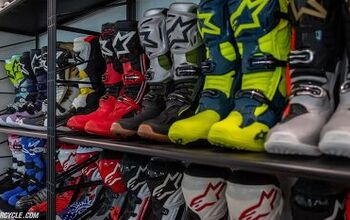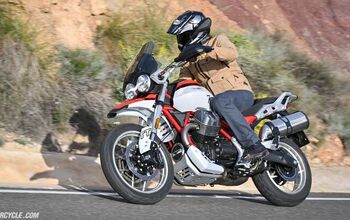Church of MO: 2000 MV Agusta F4 Strada
Yikes! $18,895 was a lot of money for a motorcycle 20 years ago, but not enough to keep friend of MO Michael Cottam from bringing home a brand new MV, flogging it for a few thousand miles, and living to tell the tale. Verily, I’m going to have to take a look at what these things are going for on the used market… it’s a good day for resurrection.
2000 MV Agusta F4 Strada
Long-Term Test
Motorcycle Online contributor, canyon carver and former GP racer, Michael Cottam, has spent some serious saddle time on MV Agusta’s new F4 Strada. With a list price of $18,895, this 750cc superbike clearly is intended for discriminating tastes. It’s sort of like a $4 espresso when a few tablets of Vivarin will get the job done quicker and cheaper.Needless to say, MV delivers Italian style and
attitude in a major way. Having logged over 3,000 miles of aggressive riding, Michael also found the MV to offer a surprisingly high level of fit, finish, reliability and even sport-touring comfort.Read on for his detailed account.
I’d ordered the MV Agusta F4 Strada a few months before my annual summer motorcycle trip.
A few friends and I take a wee tour of eastern Oregon, Nevada, and northern California each year – usually somewhere between 2,000 and 3,000 miles. Most of the trip is in the high desert where it’s very sparsely populated but littered with plenty of twisties and hilly bits where you can have a bit of fun with minimal chance of a formal interview by the guys with the flashing lights. The delivery date for the bike was typically Italian, that is to say I heard the term “next week” many times. Two months later, I still don’t have an owner’s manual… sigh.
The bike arrived about a week and a half before my trip. Interestingly, it was shipped in the crate nearly ready to go: air in the tires, brake and clutch fluid in it. Instant Italian Superbike-in-a-box… just add water (and coolant, oil and charge the battery) and go.
Given that we were going many places where it’d be hard to find a mechanic who could spell “MV” much less work on one, I wanted to get the 600 mile service out of the way while still in Portland. After a few around-town miles and post-work rides, I finished off the first 600 miles with lunch at my parent’s house. This is a 300 mile round-trip from Portland.
This was a pretty enlightening ride. While it was a blast on some great roads, I was introduced to the Marquis de Sade of motorcycle seats. A very nice little set of tools lives in a vinyl pouch under the seat. However, it feels like the tools are scattered on top of the seat instead. It made the seat on a Ducati 748 I previously owned seem pretty comfy. A quick call to Harper’s got me a gel pad, and a couple of days before we left I managed to remove the seat cover, trim the gel pad to fit, and reattach the vinyl cover. This helped enough to at least delay butt surgery for a few months.The other maintenance bit I tackled before leaving was to have Bardsley Donovan at Ron Tonkin Gran Turismo (my local dealership) replace the high-pressure fuel lines with braided steel lines. I contacted Cagiva North America through the dealer, asking about the two American magazine test bikes that had both ruptured their fuel lines (one wetting the rear tire and dumping the rider down hard), but the response from the Cagiva rep was completely unsatisfactory. He claimed that the test bikes with the problems had been Euro-version D’Oro series bikes and that they didn’t think there was a problem with my particular model. Funny thing is, both articles show bikes with black swingarms (thus contradicting the rep’s statement). Ultimately, I didn’t really think I wanted to risk my life to prove the point and just paid for the lines myself. This is disappointing, considering the general quality of the bike and the great service I’d received from the dealer so far.
The MV’s ergonomics are quite similar to the Ducati 748/916, pitching you way forward onto your hands, but with decent legroom (I’m 6’2″). Like the Ducati, a beer belly is gonna hurt you on this bike, the gas tank protruding enough to pretty much require a near-washboard stomach. Around town, stopping for lights and traffic quickly demolishes your wrists and hands since your weight is so far forward. But on the open road and in twisties, the position is fine, with the wind and/or a tank bag keeping the weight a bit further back just like on the Duc’.My friend Russ disagreed, having to pull over after maybe 20 minutes of riding. But he’s in his fifties and weighs, in his words, “an eighth of a ton.”
Surprisingly, I didn’t have a problem with the ergos on our trip that covered as much as 400 miles per day with only minor swelling. My hands and butt suffered the worst. My knees, back and feet were okay.
More by John Burns































Comments
Join the conversation
Saw the 1000 F4 version at a local dealer awhile back, what a stunning machine. They also have an RC30 and an NR750 on display, as well as a raft of cool used Ducatis, and they are not even a Duc dealer. It is a cool dealer!
Could not sit on the F4 of course, but it was quite obvious from looking at it that the bike is the most exquisitely beautiful rolling torture rack ever designed by man.
MV has a long history now of building stunning motorcycles that few can afford and few of those that can would actually buy (for various reasons). I don't know anybody who has owned an MV not to have grievously expensive mechanical problems eventually. But they are beautiful.